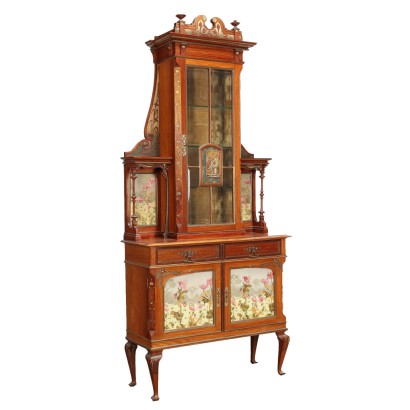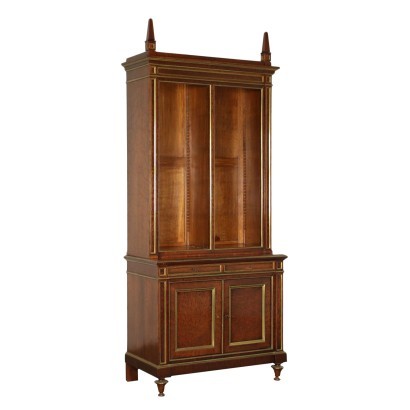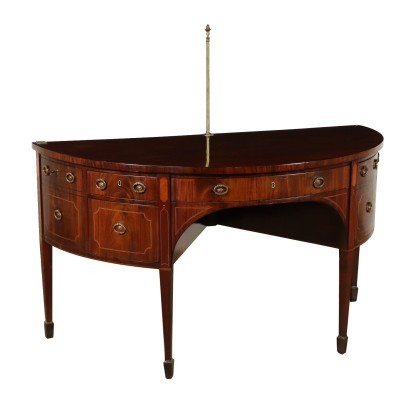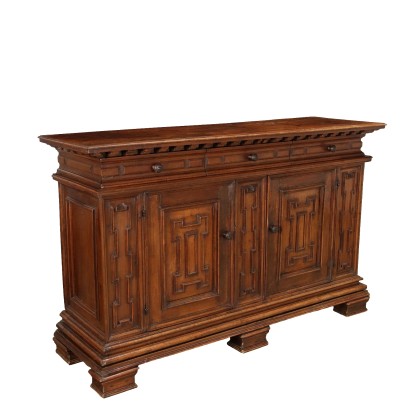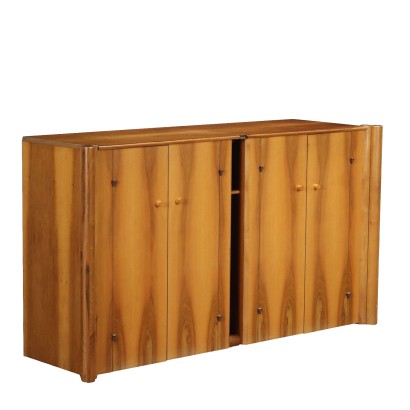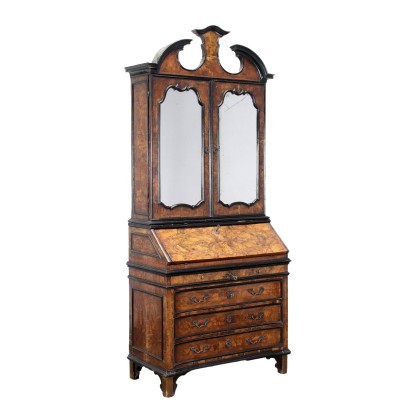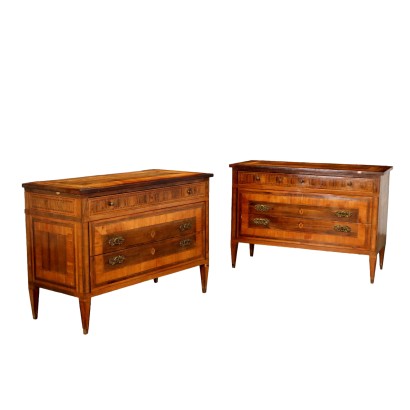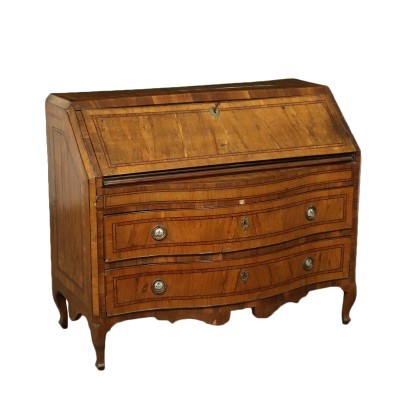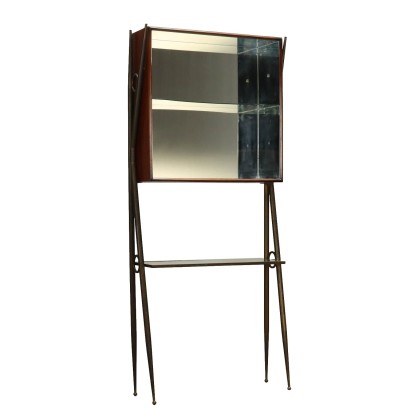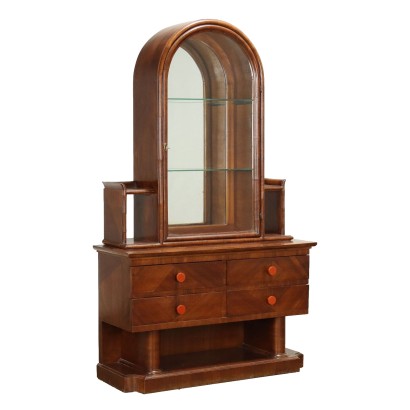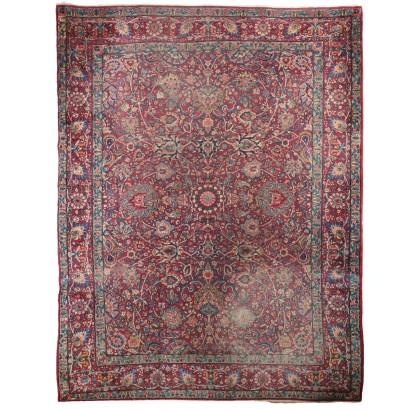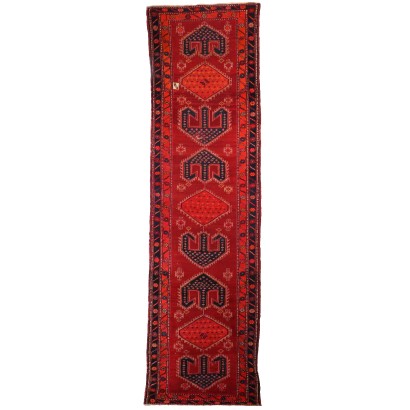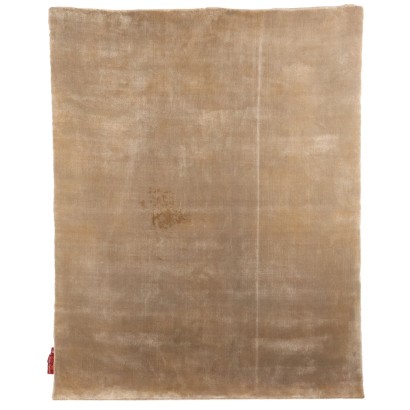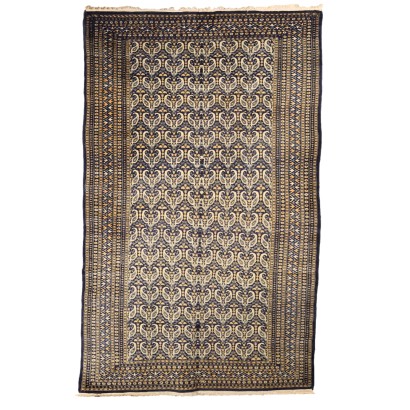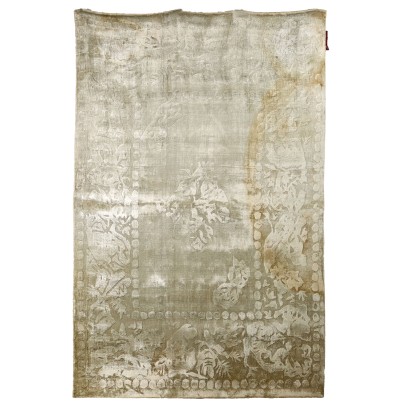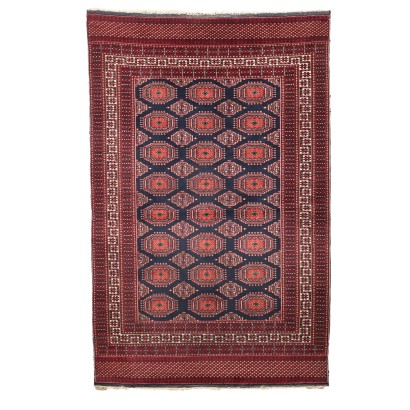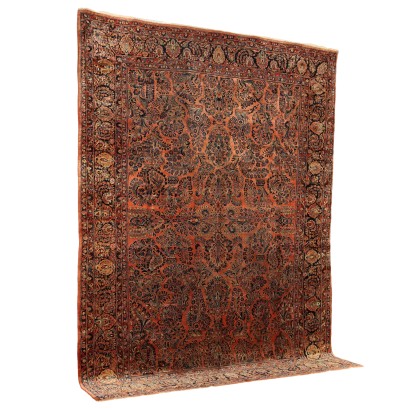Antique Showcase Art Nouveau Mahogany Italy XIX Century - Cupboard with Showcase
Features
Cupboard with Showcase
Style: Art Nouveau (1890-1920)
Age: 19th Century / 1801 - 1900
Origin: Italy
Main essence: Mahogany
Description
Small sideboard with two doors and two drawers surmounted by a showcase with side shelves supported by thin turned uprights. The panels of the doors like those of the sides of the riser contain floral ceramics, in the center of the door with glass there is a bas-relief ceramic panel with the allegory of painting, this is an indecipherable signature, on the back the "Goldchelder Wien" brand , referable to the well-known Viennese ceramics factory and engraved with the numbers "0764 / 16 / 30&". The wavy feet, the cymatium, like the rest of the piece of furniture, have small "whiplash"carvings and carved florals, defined by gilding and lacquering. Brass-coated frames, hardware, worked in floral style with partly gilded copper sheet flowers and fruits.
Product Condition:
Furniture in fair condition showing some signs of wear. We try to present the real state of the furniture as fully as possible with photos. If some details are not clear from the photos, what is reported in the description will prevail.
Dimensions (cm):
Height: 260
Width: 117
Depth: 44
Certificate issued by: Enrico Sala
Additional Information
Style: Art Nouveau (1890-1920)
Historical stylistic period formed from the end of the 19th century (c. 1890) after the Umbertino style and continued until the First World War.The current was characterized by the floral influence and the soft and curved lines, a typical example are the "whiplashes".
The first signs of this new era came from architects such as Hector Guimard (1867-1942) who built numerous buildings and hotels, but also from people such as Arthur Mackmurdo furniture designer and Arthur Liberty late 19th century London industrial and merchant who began to produce upholstery fabrics with floral motifs with soft and sinuous shapes.
The 1900 Paris Universal Exposition was an important point for the development and affirmation of Liberty in the following decade.
Liberty was called in different ways according to the nation, universally known as Art-Nouveau and it is thought that Arthur Liberty derives the name given in Italy to this beautiful stylistic current.
The name Art-Nouveau, on the other hand, is thought to derive from a shop located in Paris called Maison de l'Art Nouveau which began to show off furniture items with a new and innovative design in its windows.
With the end of the First World War, the naturalistic period of Liberty ended and the Art-Decò style emerged with more rigid and geometric lines.
Find out more about the Liberty style with our insights:
Art Nouveau: birth and development of a style
Milan Liberty between flowers and colors
The Liberty of Carlo Zen
Decorative forms and elegance in a Liberty lounge
FineArt: Eoloe Cupido, Liberty sculpture by Luca Madrassi
FineArt: Nymph and Faun, Art Nouveau sculpture by Giuseppe Siccardi
Age: 19th Century / 1801 - 1900
19th Century / 1801 - 1900Main essence: Mahogany
It is one of the most precious and sought-after woods in cabinet making. It was discovered in Central America around 1600 and began to be imported to England in the 1700s. Much appreciated for its hardness and indestructibility, it became widespread following the blocking of walnut exports from France in 1720 and the consequent elimination of English import duties on mahogany from the colonies in America and India. The most valuable version comes from Cuba, but it became very expensive. At the end of the 18th century it began to be used also in France in Louis XVI, Directory and Empire furniture, its diffusion declined starting from when Napoleon, in 1810, forbade its import. It was generally used in the manufacture of elegant furniture, due to its characteristics and beautiful grain.Other customers have searched:
Vetrine, vetrina, teca, vetrinetta, scansia, mobile, scaffale, libreria..
Approfondimenti
Consulta anche le migliori librerie e vetrine su FineArt:
Libreria 'Life' Roberto Monsani per Acerbis
Libreria, Giuseppe Speluzzi, Milano, ultimo quarto XIX secolo
Libreria anni '50 manifattura italiana
Libreria anni '60
Sideboard '503' Gianfranco Frattini per Bernini
Mobile Mario Vender anni '60
Trumeau Queen Anne, Inghilterra, 1705 ca.
Sull'antiquariato in generale dai un'occhiata anche a
Classic Monday: da un pezzo dei nostri magazzini alla storia dell'antiquariato
L'antiquariato dalla A alla Z: il Dizionario dell'Antiquariato
Il dizionario dell'antiquariato - Lastronatura
Il dizionario dell'antiquariato - Mascherone
Il dizionario dell'antiquariato - Natura morta
Il dizionario dell'antiquariato - Opificio
Il dizionario dell'antiquariato - Pastiglia
Il dizionario dell'antiquariato - Savonarola
Il dizionario dell'antiquariato - Rosone
Intaglio barocco con motivo a ricciolo
Approfondimenti
Consulta anche le migliori librerie e vetrine su FineArt:Libreria 'Life' Roberto Monsani per Acerbis
Libreria, Giuseppe Speluzzi, Milano, ultimo quarto XIX secolo
Libreria anni '50 manifattura italiana
Libreria anni '60
Sideboard '503' Gianfranco Frattini per Bernini
Mobile Mario Vender anni '60
Trumeau Queen Anne, Inghilterra, 1705 ca.
Sull'antiquariato in generale dai un'occhiata anche a
Classic Monday: da un pezzo dei nostri magazzini alla storia dell'antiquariato
L'antiquariato dalla A alla Z: il Dizionario dell'Antiquariato
Il dizionario dell'antiquariato - Lastronatura
Il dizionario dell'antiquariato - Mascherone
Il dizionario dell'antiquariato - Natura morta
Il dizionario dell'antiquariato - Opificio
Il dizionario dell'antiquariato - Pastiglia
Il dizionario dell'antiquariato - Savonarola
Il dizionario dell'antiquariato - Rosone
Intaglio barocco con motivo a ricciolo
Product availability
The product can be seen at Cambiago
Disponibilità immediata
Pronto per la consegna in 2 giorni lavorativi dalla conferma dell'ordine del prodotto.
Consegna tra i 7 e i 15 giorni in tutta Italia. Per le isole e le zone difficilmente raggiungibili i tempi di consegna possono variare.



